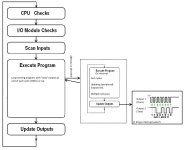(This is a rather theoretical question)
Let's say I've got a slow program with a cycle time of 200ms.
And I want to be able to set an output within 10ms after someone pressed a button.
How does the interrupt "break" the cycle?
Is it another cycle/piece that runs every 10ms?
Or is it actually something that only happens when one input becomes high?
How does the PLC know that an input has changed (since the PLC only checks inputs at the beginning of a cycle).
And will the interrupt cause my output to go high directly? (since the PLC only sets outputs at the end of a cycle?)
I'm thinking of using a Siemens S7-315 PLC, what latency can I expect (time from input signal to output signal going high).
Let's say I've got a slow program with a cycle time of 200ms.
And I want to be able to set an output within 10ms after someone pressed a button.
How does the interrupt "break" the cycle?
Is it another cycle/piece that runs every 10ms?
Or is it actually something that only happens when one input becomes high?
How does the PLC know that an input has changed (since the PLC only checks inputs at the beginning of a cycle).
And will the interrupt cause my output to go high directly? (since the PLC only sets outputs at the end of a cycle?)
I'm thinking of using a Siemens S7-315 PLC, what latency can I expect (time from input signal to output signal going high).
Last edited:






